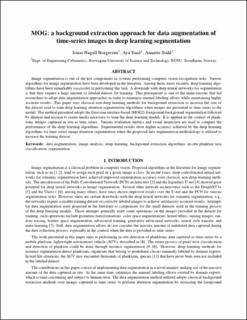| dc.contributor.author | Borgersen, Jonas Nagell | |
| dc.contributor.author | Saad, Aya | |
| dc.contributor.author | Stahl, Annette | |
| dc.date.accessioned | 2022-10-13T10:47:20Z | |
| dc.date.available | 2022-10-13T10:47:20Z | |
| dc.date.created | 2021-06-09T10:23:04Z | |
| dc.date.issued | 2021 | |
| dc.identifier.issn | 0277-786X | |
| dc.identifier.uri | https://hdl.handle.net/11250/3025864 | |
| dc.description.abstract | Image segmentation is one of the key components in systems performing computer vision recognition tasks. Various algorithms for image segmentation have been developed in the literature. Among them, more recently, deep learning algorithms have been remarkably successful in performing this task. A downside with deep neural networks for segmentation is that they require a large amount of labeled dataset for training. This prerequisite is one of the main reasons that led researchers to adopt data augmentation approaches in order to minimize manual labeling efforts while maintaining highly accurate results. This paper uses classical non-deep learning methods for background extraction to increase the size of the dataset used to train deep learning attention segmentation algorithms when images are presented as time-series to the model. The method presented adopts the Gaussian mixture-based (MOG2) foreground-background segmentation followed by dilation and erosion to create masks necessary to train the deep learning models. It is applied in the context of planktonic images captured in situ as time series. Various evaluation metrics and visual inspection are used to compare the performance of the deep learning algorithms. Experimental results show higher accuracy achieved by the deep learning algorithms for time-series image attention segmentation when the proposed data augmentation methodology is utilized to increase the training dataset. | en_US |
| dc.language.iso | eng | en_US |
| dc.publisher | SPIE | en_US |
| dc.subject | Klassifisering | en_US |
| dc.subject | Classification | en_US |
| dc.subject | Segmentering | en_US |
| dc.subject | Segmentation | en_US |
| dc.subject | Maskinlæring | en_US |
| dc.subject | Machine learning | en_US |
| dc.subject | Deep learning | en_US |
| dc.subject | Deep learning | en_US |
| dc.subject | Datasyn | en_US |
| dc.subject | Computer Vision | en_US |
| dc.title | MOG: a background extraction approach for data augmentation of time-series images in deep learning segmentation | en_US |
| dc.type | Journal article | en_US |
| dc.type | Peer reviewed | en_US |
| dc.description.version | acceptedVersion | en_US |
| dc.rights.holder | Copyright 2022 Society of Photo Optical Instrumentation Engineers (SPIE). One print or electronic copy may be made for personal use only. Systematic reproduction and distribution, duplication of any material in this publication for a fee or for commercial purposes, and modification of the contents of the publication are prohibited. | en_US |
| dc.source.journal | Proceedings of SPIE, the International Society for Optical Engineering | en_US |
| dc.identifier.doi | 10.1117/12.2622899 | |
| dc.identifier.cristin | 1914746 | |
| dc.relation.project | Norges forskningsråd: 223254 | en_US |
| dc.relation.project | Norges forskningsråd: 262741 | en_US |
| cristin.ispublished | true | |
| cristin.fulltext | postprint | |
| cristin.qualitycode | 1 | |
